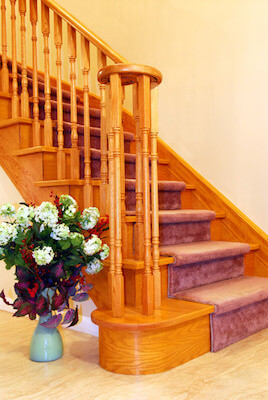How To Get Stair Runners Right
If you have wood stairs in your home, you’re probably used to the loud sounds that echo through your home with every step taken. That clomp, clomp, bang, bang noise becomes something that’s hard to put out of your mind, especially if you have a lot of foot traffic inside.
Kids are notorious for flying up and down the stairs, over and over again in hot pursuit of the next adventure in their minds. And sometimes, the occasional “aaaugh” is followed by a bump at the end as they miss a step and slide down to the bottom. Yes, wood stairs can be noisy. And depending on the style, they can be very slippery as well.
Which is why many homeowners turn to stair runners as a solution to provide both peace and quiet and added safety to your stairs. They can be simple and understated, or add their own design and character to your home.
Of course, adding a stair runner to your home can bring up a lot of questions.
- How wide should they be?
- What do I do with landing space in between?
- Where should the runner end?
There are many ways to answer the most common questions. Here are a few ideas to help get you started.
Where should the runner end?
This depends on a variety of things. Do your stairs have an overhang? You can end the runner at the base of the overhang. What floor surface do the stairs come in contact with at both levels? You can use that to help you define how to finish off your design. There really isn’t a right or wrong way to end a stair runner. The important thing is that it provides flow and dimension to your overall design. You can do a few searches online and find many examples – use them to help you decide the best look for your home.
How wide should they be?
As a general rule of thumb, leaving 4 inches of bare wood on either side of the stair runner will give you a pleasing look. This should provide you with enough width to be a comfortable path for walking. Yet you can adjust the look and feel depending on your style and preference, and the overall look you are hoping to achieve.
What do I do with landing space in between?
In many cases, it depends on the size of the landing. And your style and personality comes into play too. Is the landing large enough for furniture? Leaving it wood and laying a rug may be an option. Is there just enough for a turn, to move the stairs into a new direction? How about covering the landing completely with carpet before continuing with the stair runner down the stairs? If you use area rugs either at a landing between two sets of stairs, or at the entry at the base, be sure to use non-slip pads under the rug so they won’t wiggle and move as you walk across. This can also be important if children often run and jump from stairs to landing, giving them the added security of not falling down.
How do I handle stairs that change width?
Especially with a grand staircase that opens up into a large room, you’ll often find stairs that get wider as they open into the room. Should you continue a stair runner down at the same width? Doing so gives you consistency and continues the visual appearance all the way through. But it isn’t your only option. In some cases, extending the stair runner and taking up more space can soften the look and provide more coverage for safety. The key is having a pattern in mind and continuing it all the way through, from top to bottom.
Have additional questions about how to incorporate a stair runner into your home?
